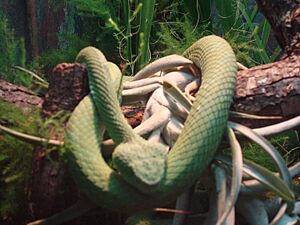Bothriechis rowleyi facts for kids
Quick facts for kids Bothriechis rowleyi |
|
|---|---|
 |
|
| Conservation status | |
| Scientific classification | |
| Genus: |
Bothriechis
|
| Species: |
rowleyi
|
 |
|
| Synonyms | |
|
|
The Mexican palm-pitviper (scientific name: Bothriechis rowleyi) is a type of venomous snake. It belongs to a group of snakes called pit vipers. These snakes are known for their heat-sensing pits on their faces. The Mexican palm-pitviper lives only in Mexico. It is a unique species, meaning there are no different types (subspecies) of it.
Why is it Called Rowleyi?
The second part of the snake's scientific name, rowleyi, honors an American bird expert named John Stuart Rowley. He was one of the people who first collected a sample of this snake for science.
What Does it Look Like?
The Mexican palm-pitviper is a thin, green snake. It has a special tail that can grip things, like branches. This is called a prehensile tail. Adult snakes can grow to be about 97 centimeters (or about 38 inches) long, including their tail.
Where Does it Live?
This snake is found in Mexico. It lives in the southeastern part of Oaxaca and the northern part of Chiapas. It prefers to live in cloud forests, which are high up in the mountains. You can find it at altitudes between 1,500 and 1,830 meters (about 4,900 to 6,000 feet) above sea level.
The first place this snake was officially found was on a ridge near Rancho Vicente. This area is close to the headwaters of the Grijalva River.
Is it in Danger?
The Mexican palm-pitviper is listed as Vulnerable (VU) on the IUCN Red List of Threatened Species. This means it faces a high risk of becoming extinct in the wild.
A species is called vulnerable when its habitat is shrinking. Also, its population might be small or spread out in only a few places. For this snake, its living area is estimated to be less than 20,000 square kilometers (about 7,700 square miles). The actual area it lives in is even smaller, less than 2,000 square kilometers (about 770 square miles). Scientists have seen that its habitat is getting smaller or losing its quality.


